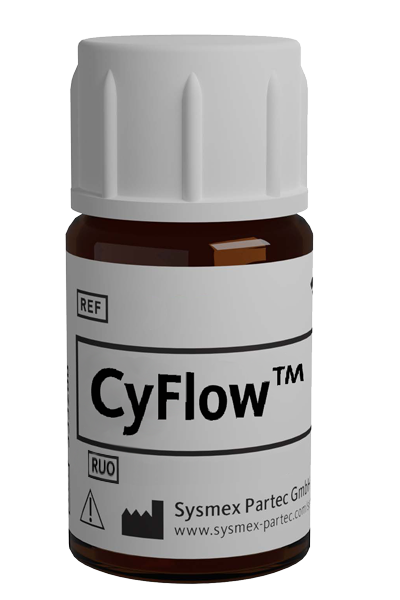CyFlow™ CD106 PE

| Alternative Name: | INCAM-110, VCAM-1 |
| Antibody: | Yes |
| Antigen: | CD106 |
| Application: | Flow cytometry |
| Clonality: | monoclonal |
| Clone: | STA |
| Emission Maximum: | 576 nm |
| Excitation Maximum: | 496 nm, 565 nm |
| Field of Interest: | Immunophenotyping |
| Format/Fluorochrome: | PE |
| Isotype: | IgG1 |
| Laser: | Blue , Green, Yellow |
| Regulatory Status: | RUO |
| Source Species: | Mouse |
| Target Species: | Human |
| Product number: | BK202948 |
For Research Use Only
| HLDA Workshop | HLDA V—WS Code A013 |
| Quantity | 100 tests |
| Volume | 2.0 mL |
| Immunogen | Human DS6 T cells |
| Background Information | CD106 (VCAM-1; vascular cell adhesion molecule-1) is an Ig-like cell surface adhesion molecule binding VLA-4 integrin. VCAM-1 is a potent T cell costimulatory molecule taking part in their positive selection and survival, as well as in adhesion, transendothelial migration and activation of peripheral T cells. VCAM-1 is also involved in endothelial cell-cell contacts. Whereas VCAM-1 normally mediates leukocyte extravasion to sites of tissue inflammation, tumor cells can use overexpressed VCAM-1 to escape T cell immunity. Soluble form of VCAM-1 (sVCAM-1) is an inflammatory marker and can be used also in prognosis of subsequent cariovascular events following acute coronary syndromes. |
| Usage | The reagent is designed for Flow Cytometry analysis of human blood cells. Recommended usage is 20·µl reagent·/ 100·µl of whole blood or 10^6 cells in a suspension. The content of a vial (2 ml) is sufficient for 100 tests. |
| Storage Buffer | The reagent is provided in stabilizing phosphate buffered saline (PBS) solution, pH ≈7.4, containing 0.09% (w/v) sodium azide. |
| Storage | Avoid prolonged exposure to light. Store in the dark at 2-8°C. Do not freeze. |
| Stability | Do not use after expiration date stamped on vial label. |
| Doussis IA, Gatter KC, Mason DY: CD68 reactivity of non‑macrophage derived tumours in cytological specimens. J Clin Pathol. 1993 Apr; 46(4):334‑6. < PMID: 7684403 > | Leca G, Mansur SE, Bensussan A: Expression of VCAM‑1 (CD106) by a subset of TCR gamma delta‑bearing lymphocyte clones: Involvement of a metalloprotease in the specific hydrolytic release of the soluble isoform. J Immunol. 1995 Feb 1; 154(3):1069‑77. < PMID: 7529789 > | van Wetering S, van den Berk N, van Buul JD, Mul FP, Lommerse I, Mous R, ten Klooster JP, Zwaginga JJ, Hordijk PL: VCAM‑1‑mediated Rac signaling controls endothelial cell‑cell contacts and leukocyte transmigration. Am J Physiol Cell Physiol. 2003 Aug; 285(2):C343‑52. < PMID: 12700137 > | Yen YT, Liao F, Hsiao CH, Kao CL, Chen YC, Wu-Hsieh BA: Modeling the early events of severe acute respiratory syndrome coronavirus infection in vitro. J Virol. 2006 Mar; 80(6):2684‑93. < PMID: 16501078 > | Wu TC: The role of vascular cell adhesion molecule‑1 in tumor immune evasion. Cancer Res. 2007 Jul 1; 67(13):6003‑6. < PMID: 17616653 > | Postadzhiyan AS, Tzontcheva AV, Kehayov I, Finkov B: Circulating soluble adhesion molecules ICAM‑1 and VCAM‑1 and their association with clinical outcome, troponin T and C‑reactive protein in patients with acute coronary syndromes. Clin Biochem. 2007 Sep 19; < PMID: 23105687 > | Paessens LC, Singh SK, Fernandes RJ, van Kooyk Y: Vascular cell adhesion molecule‑1 (VCAM‑1 and intercellular adhesion molecule‑1 (ICAM‑1 provide co‑stimulation in positive selection along with survival of selected thymocytes. Mol Immunol. 2008 Jan; 45(1):42‑8. < PMID: 17604837 >
